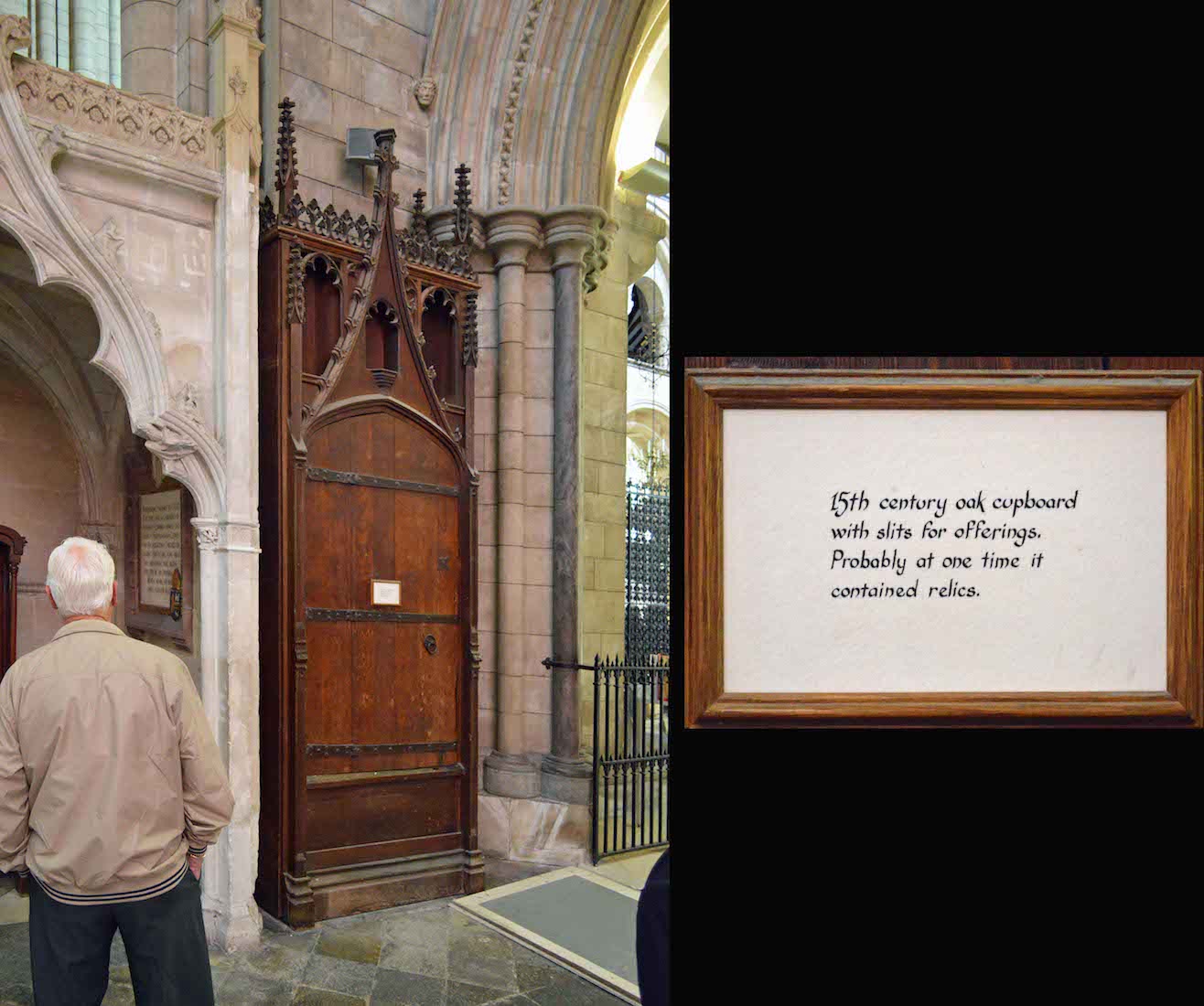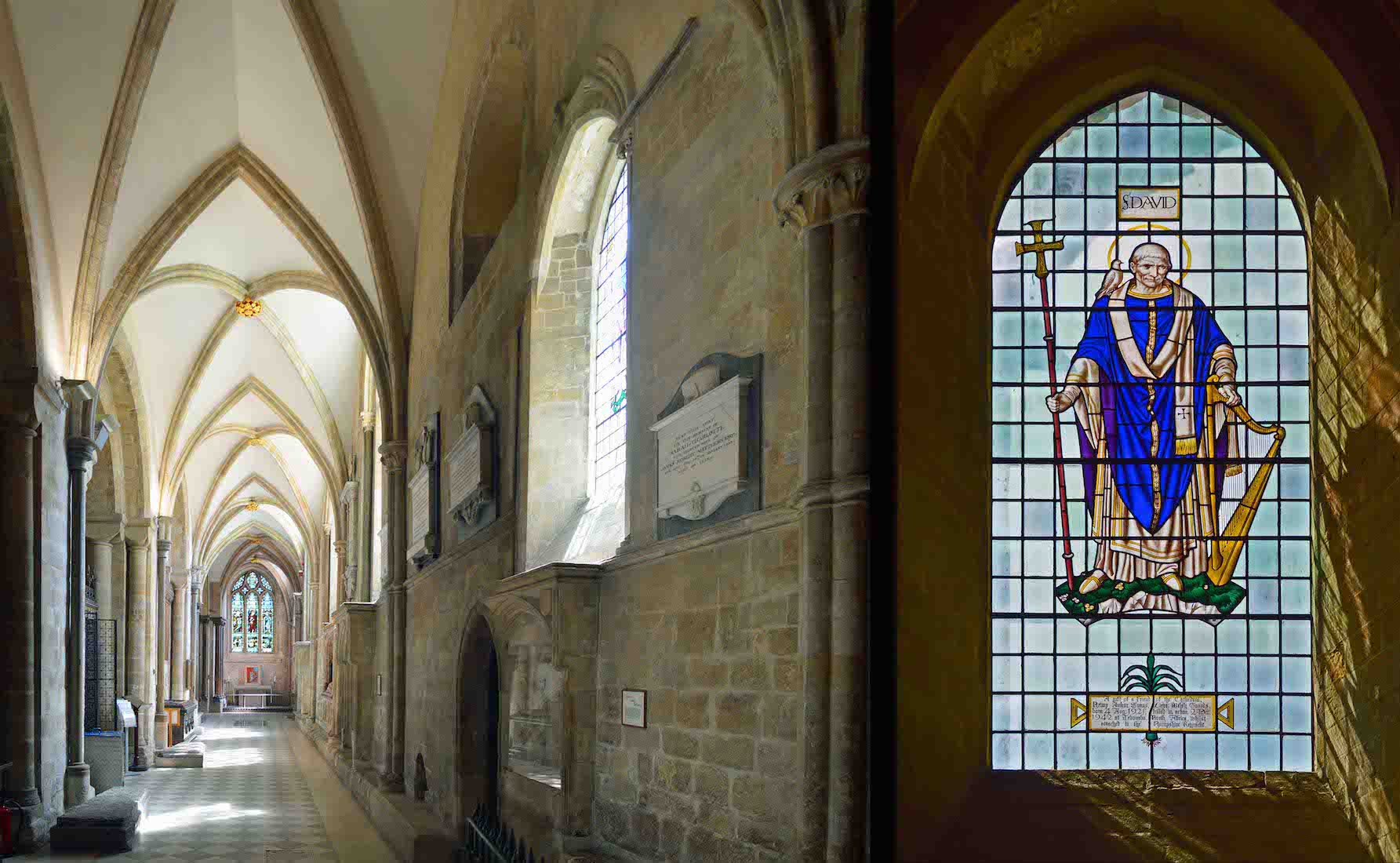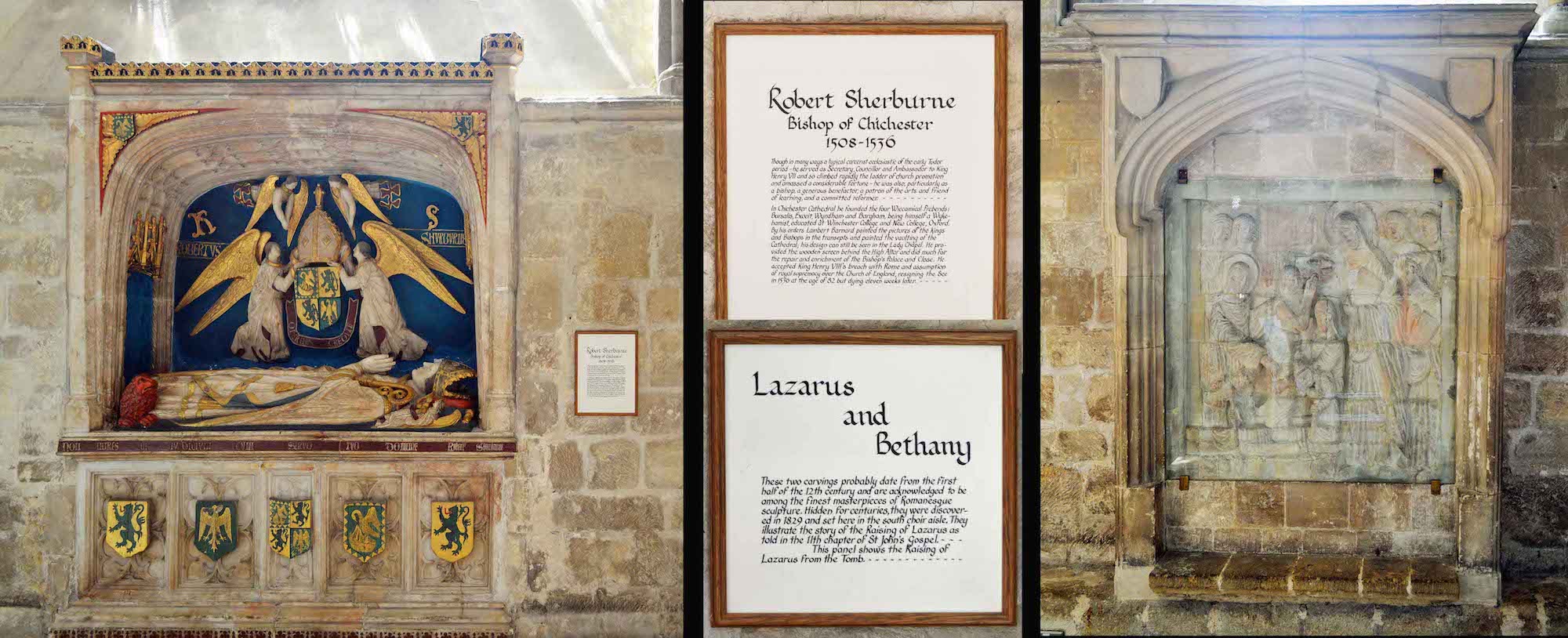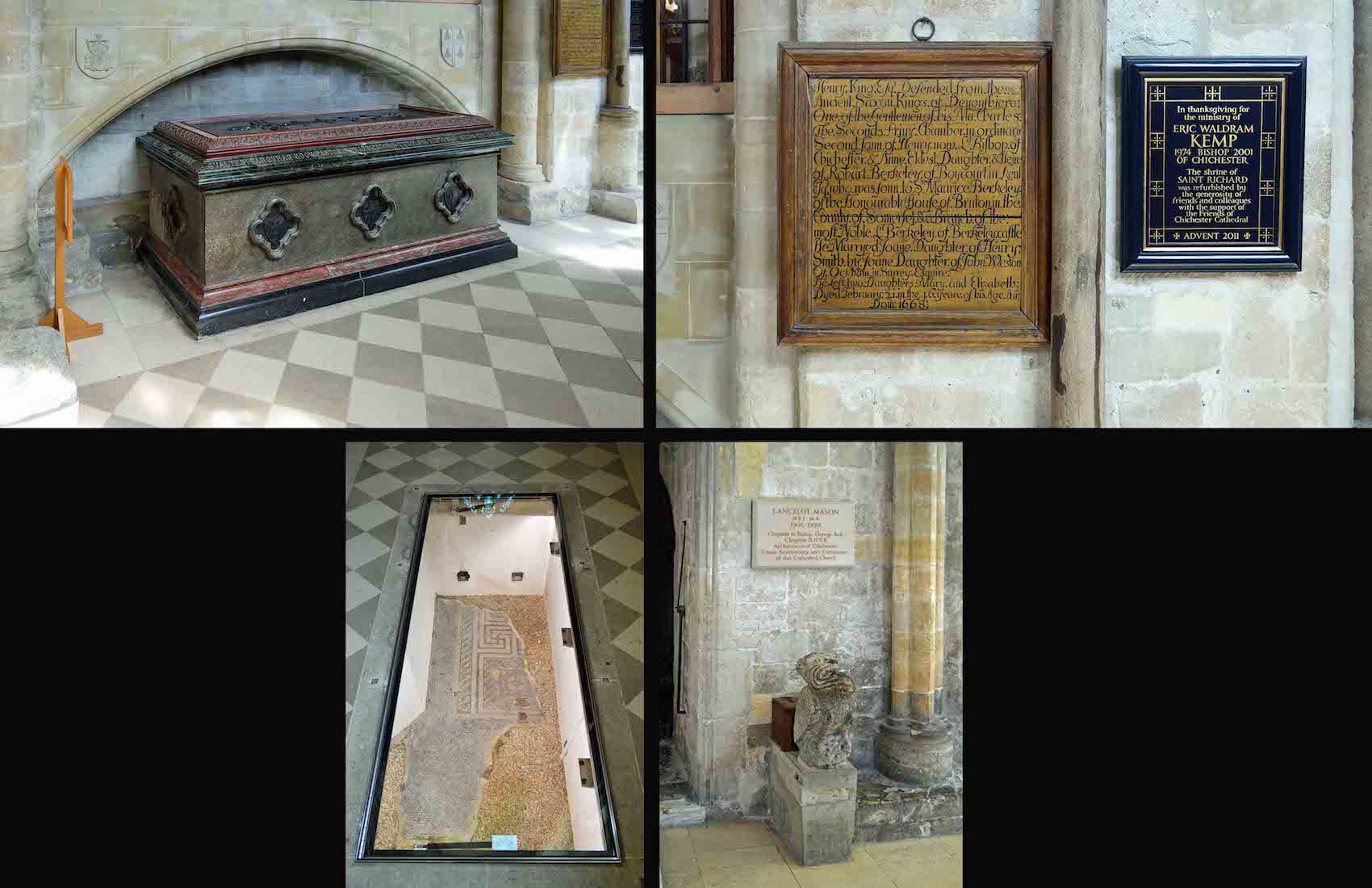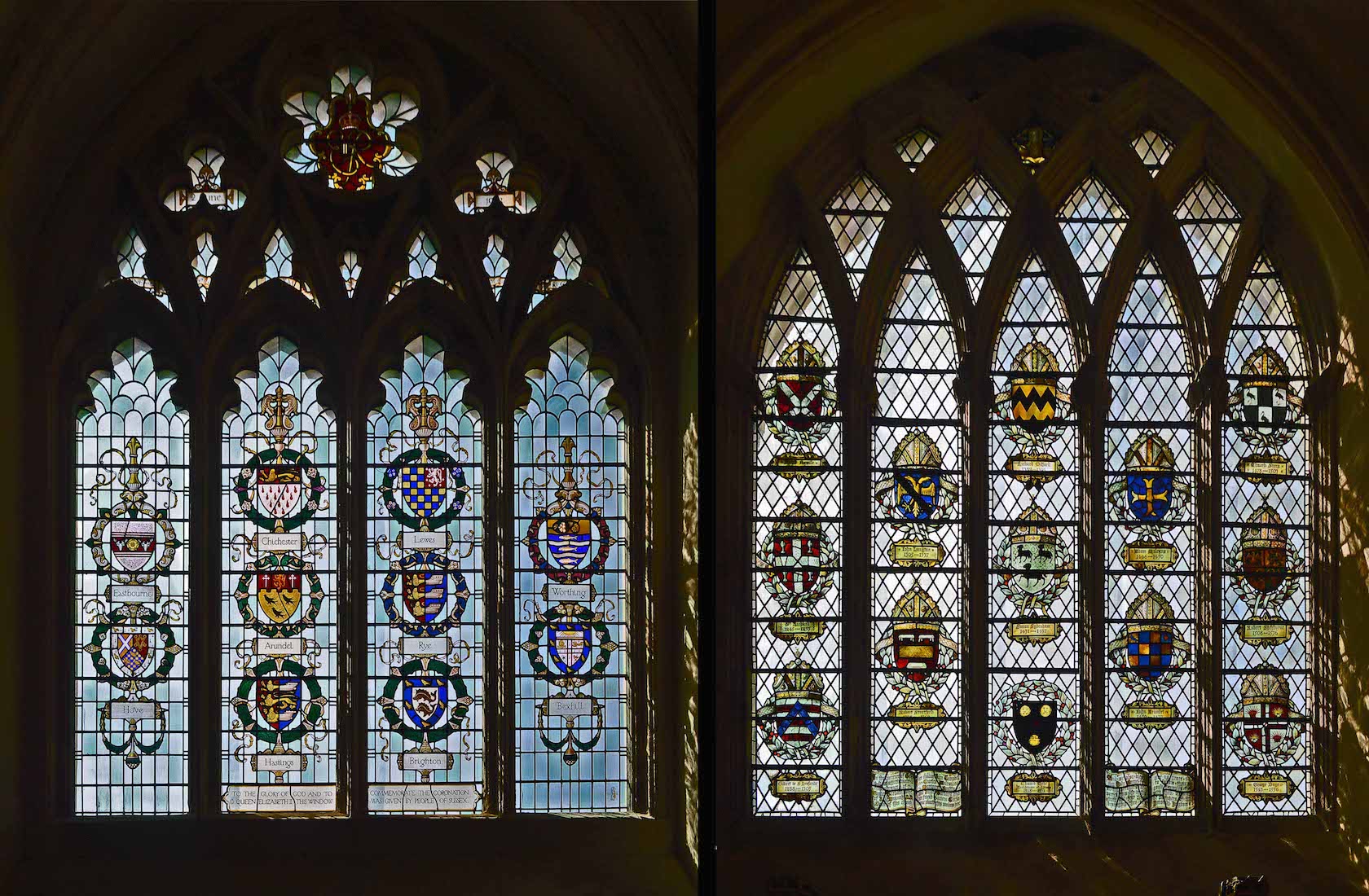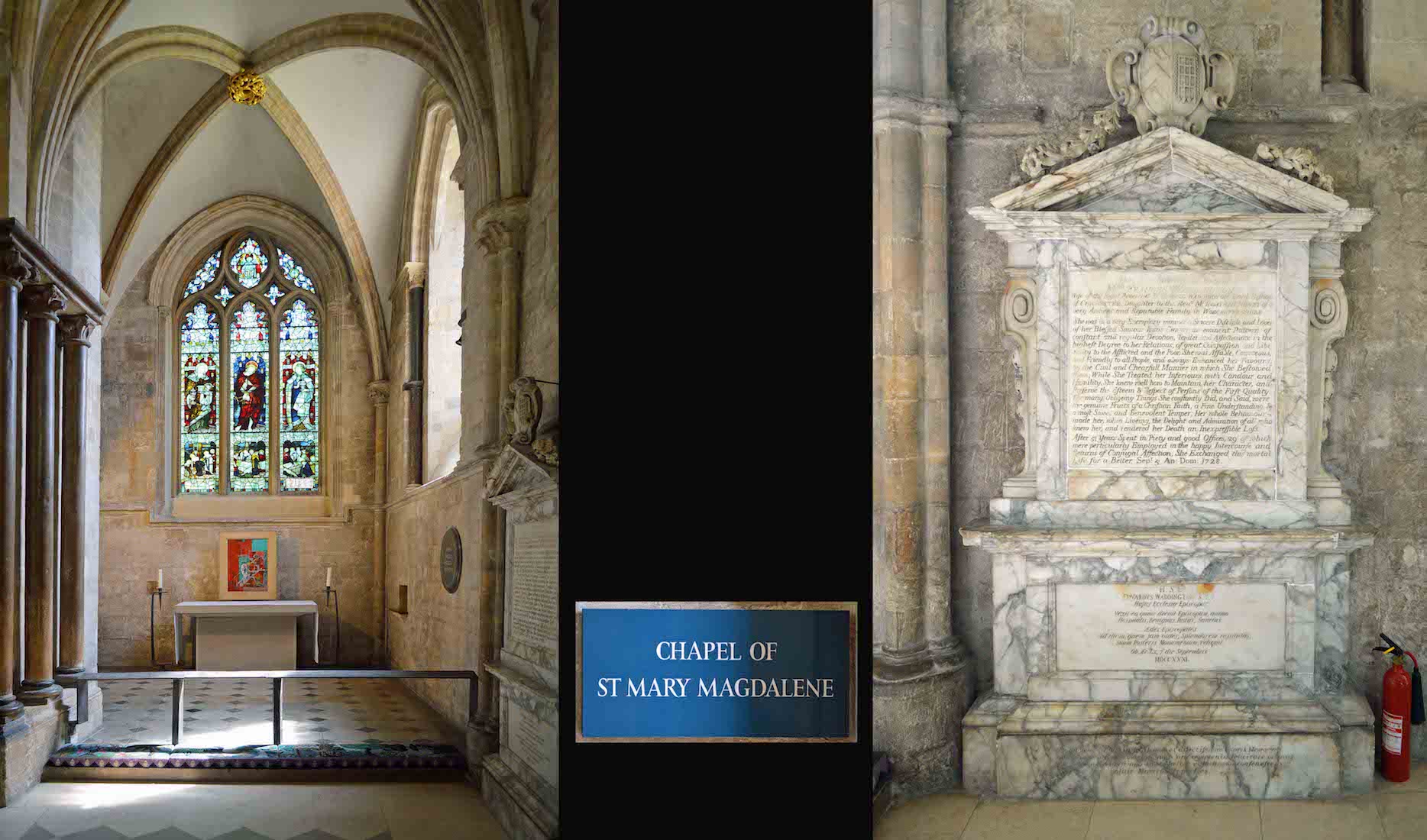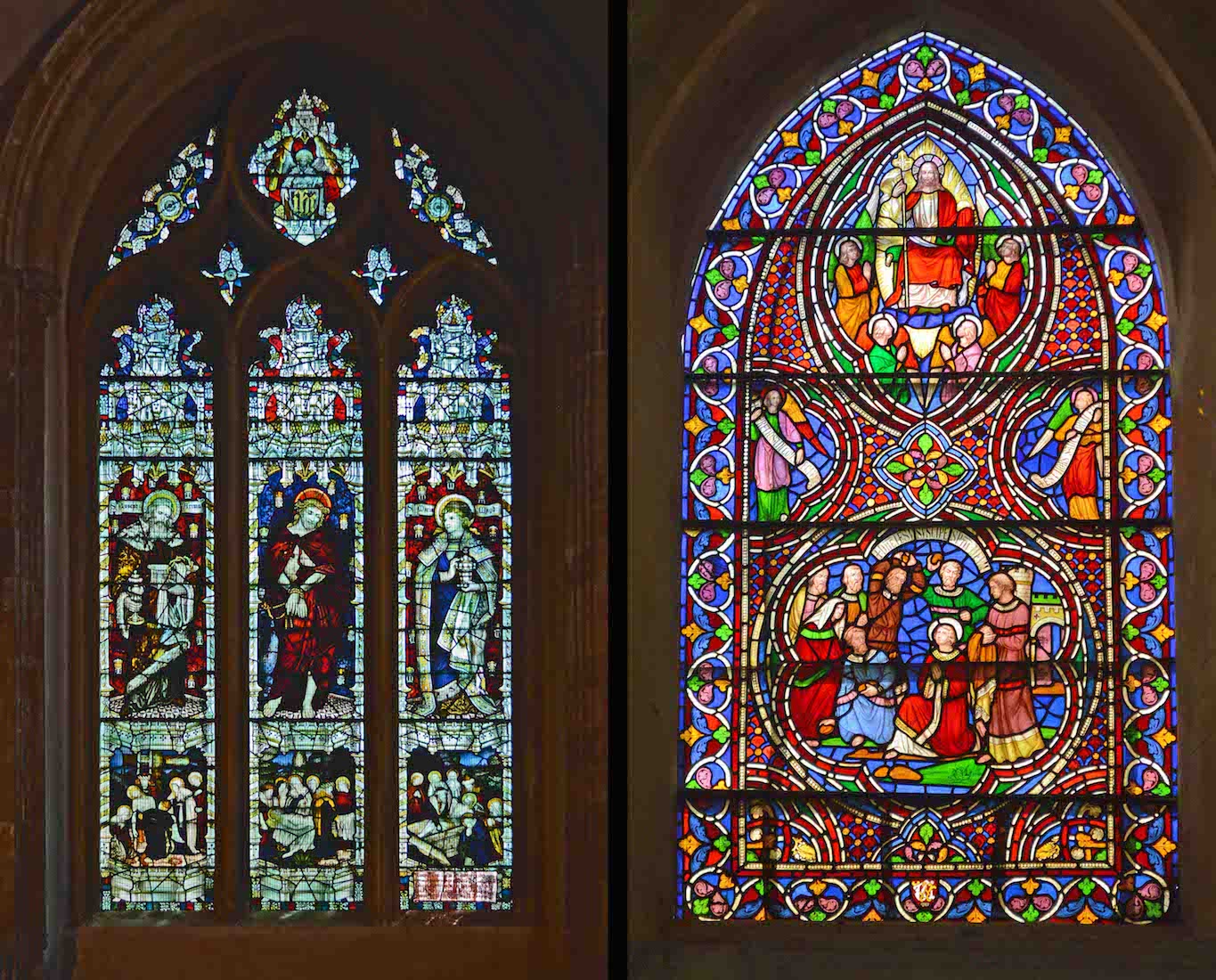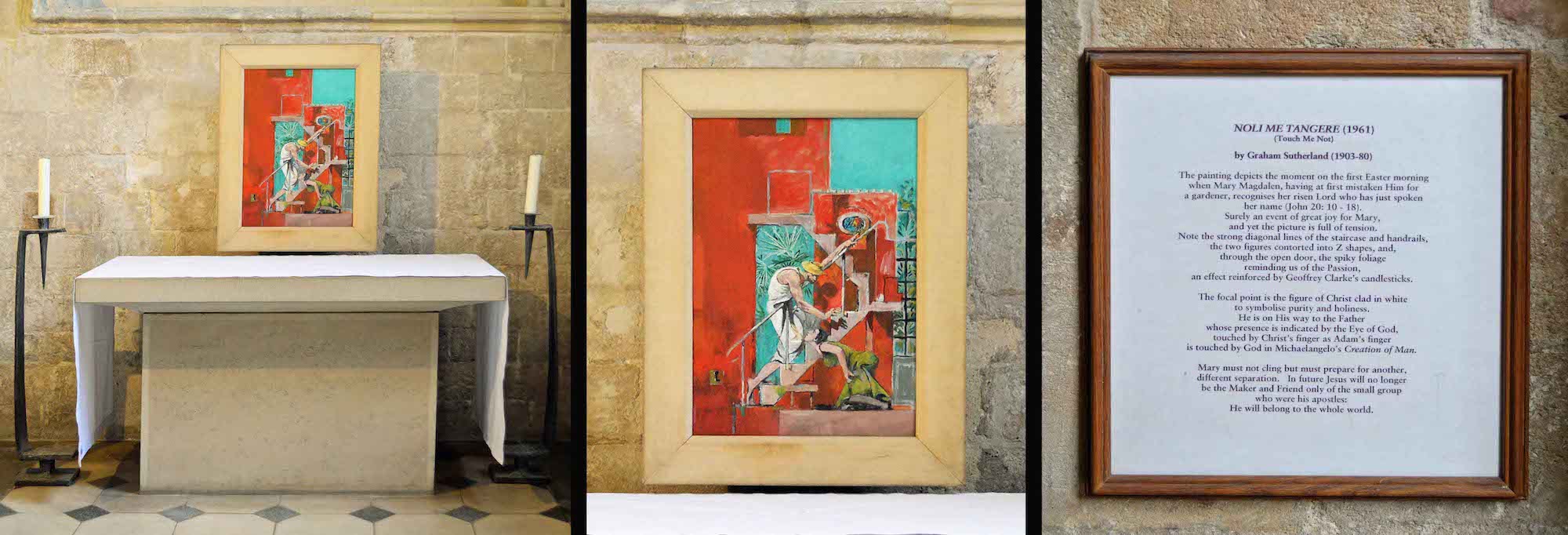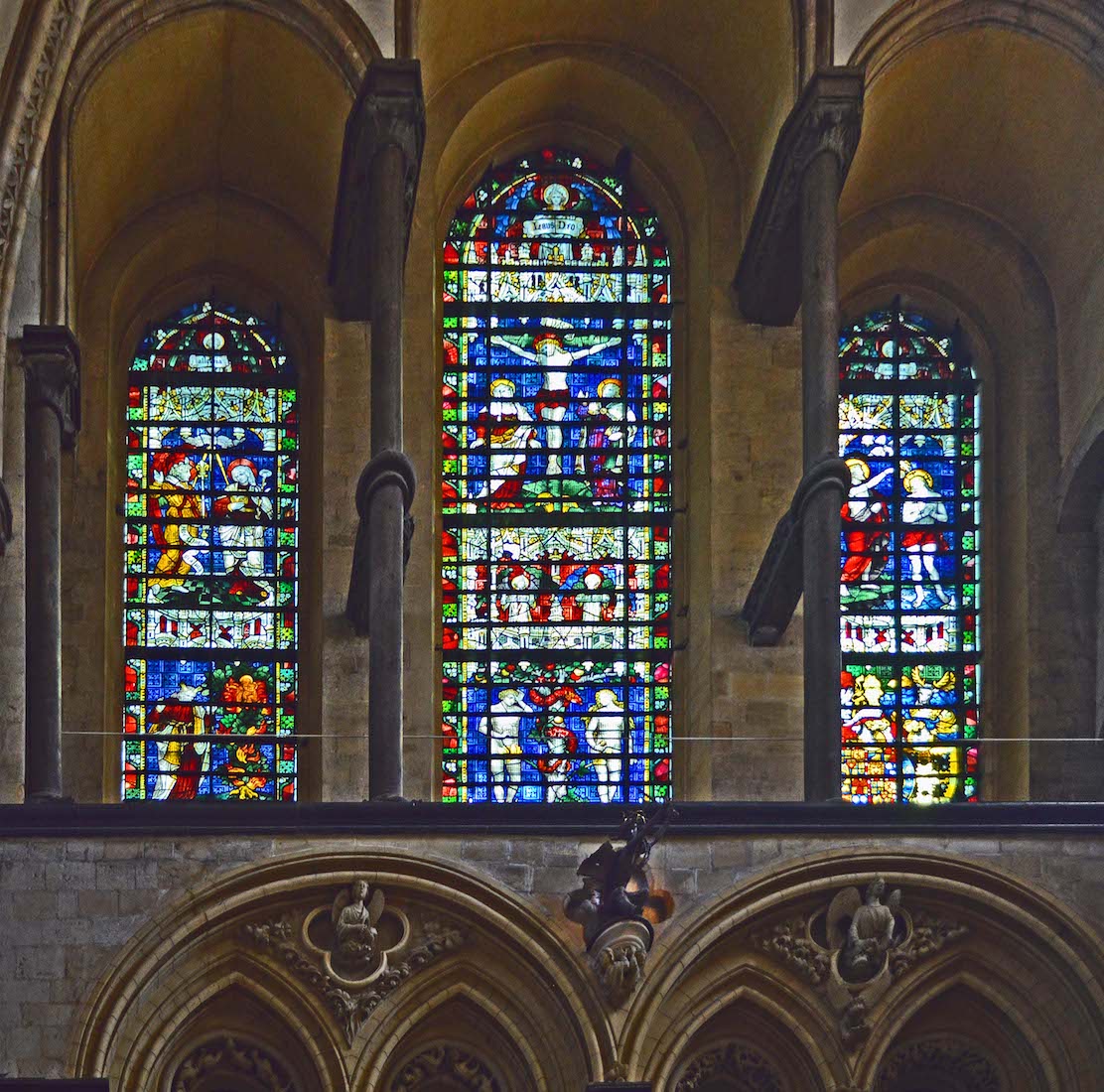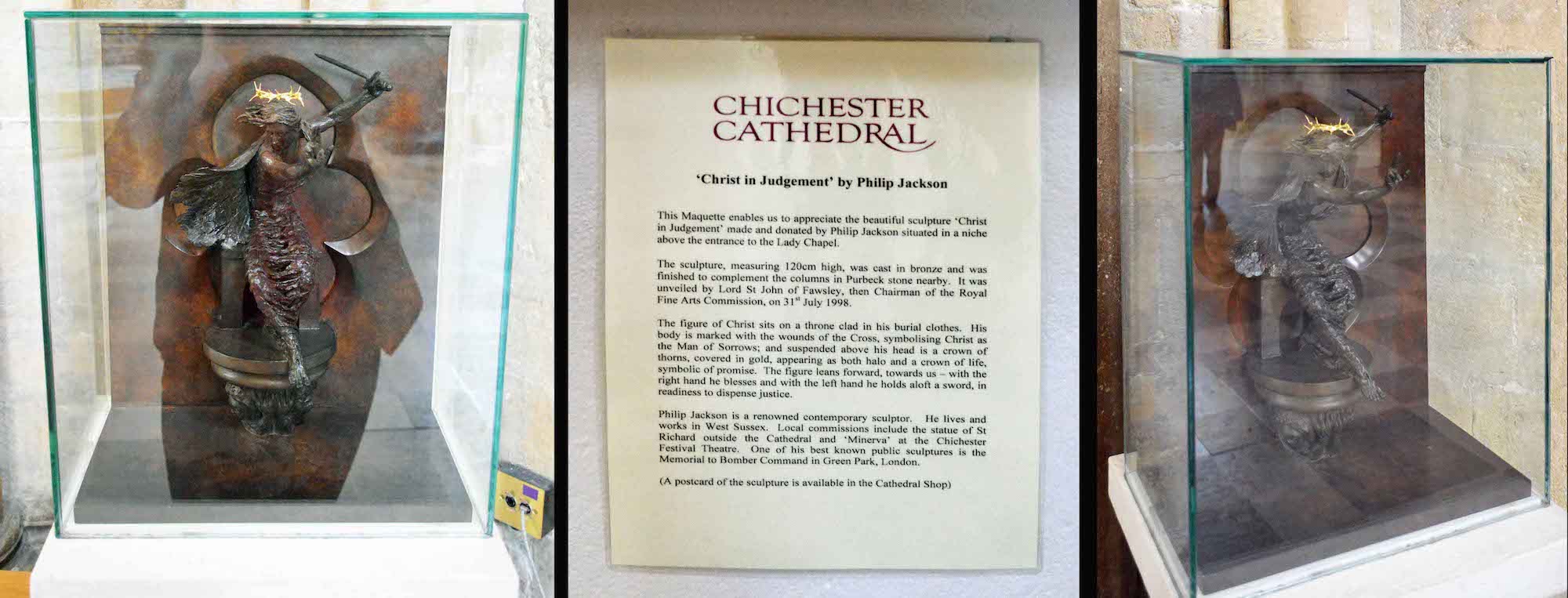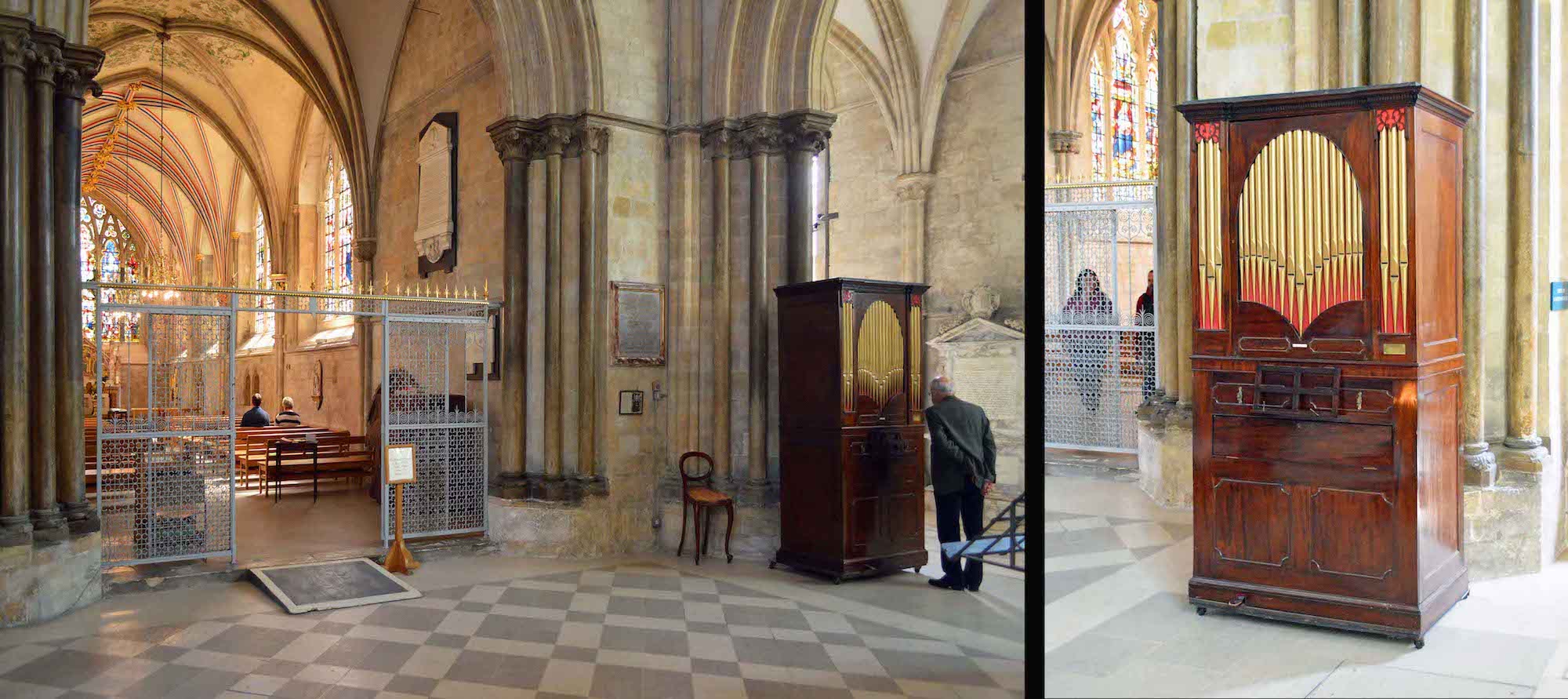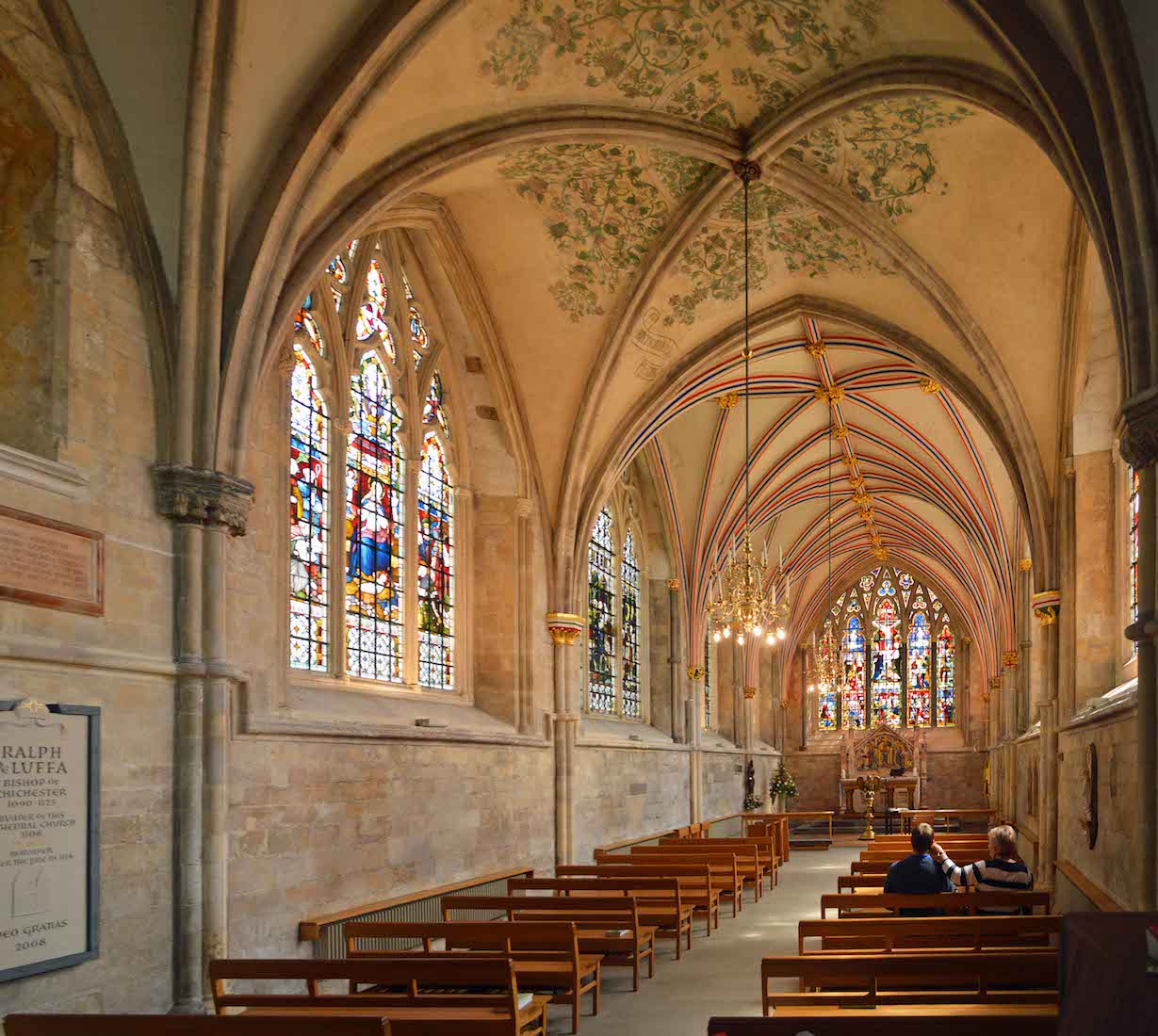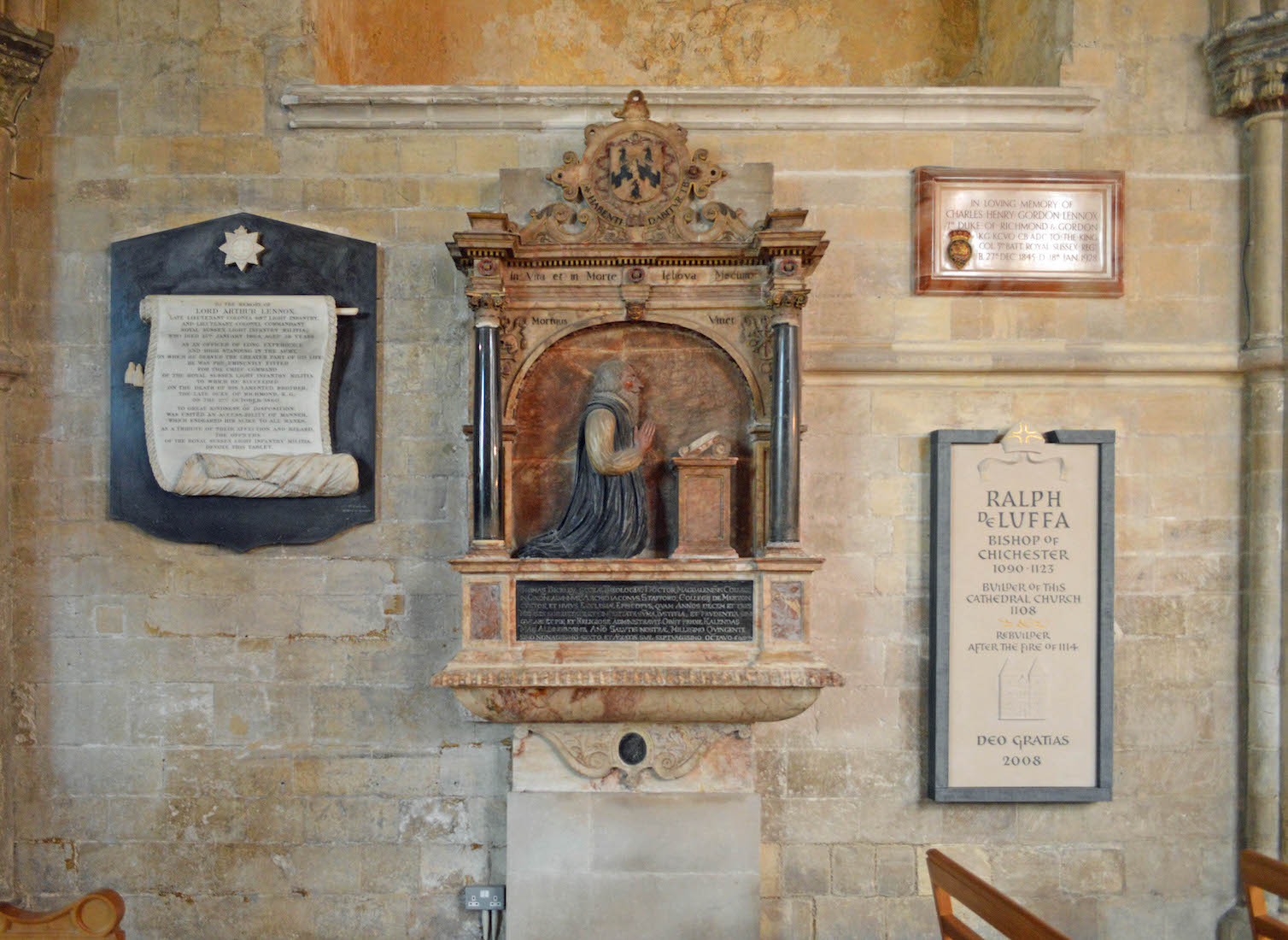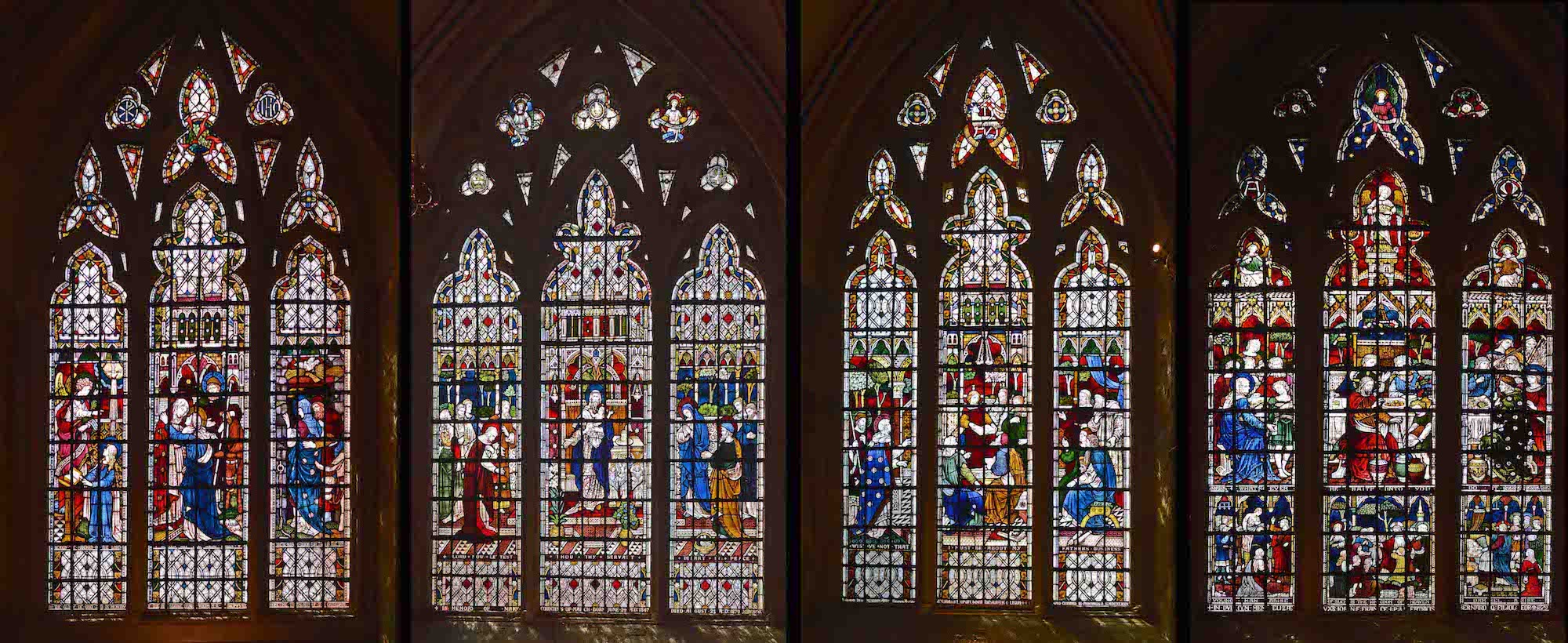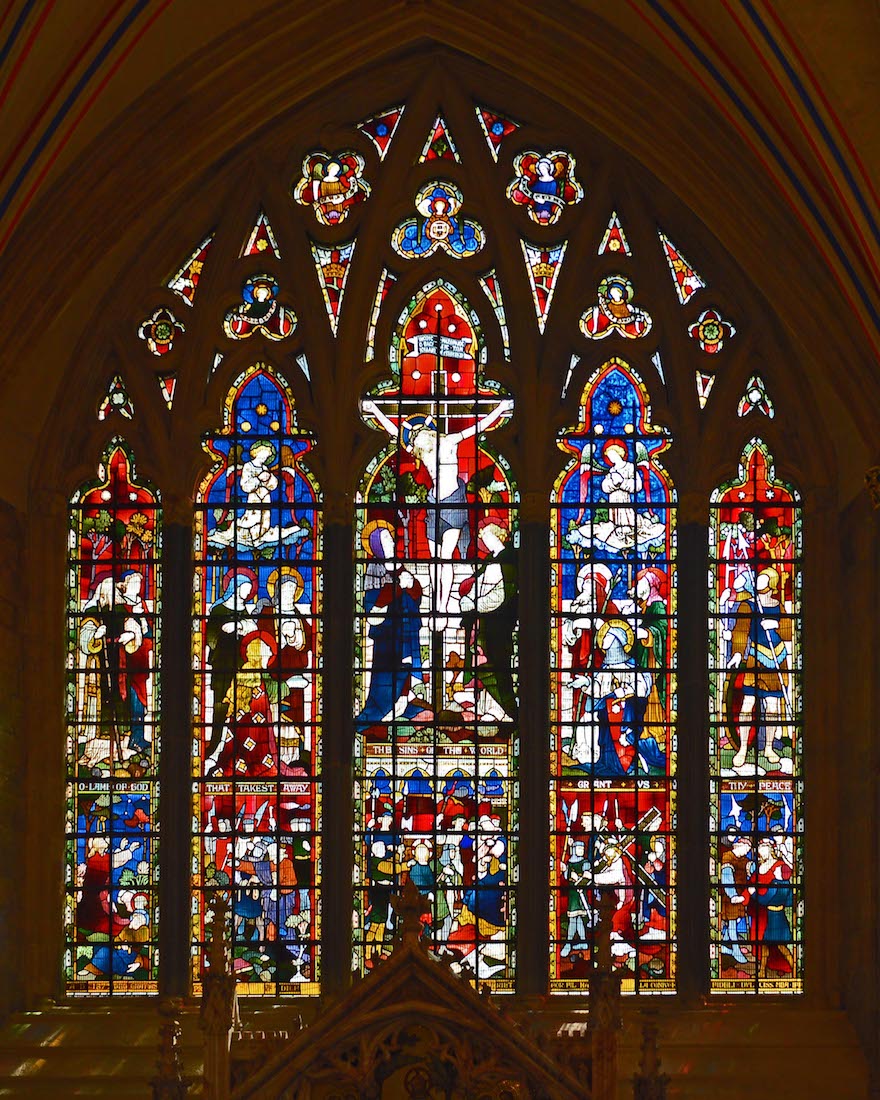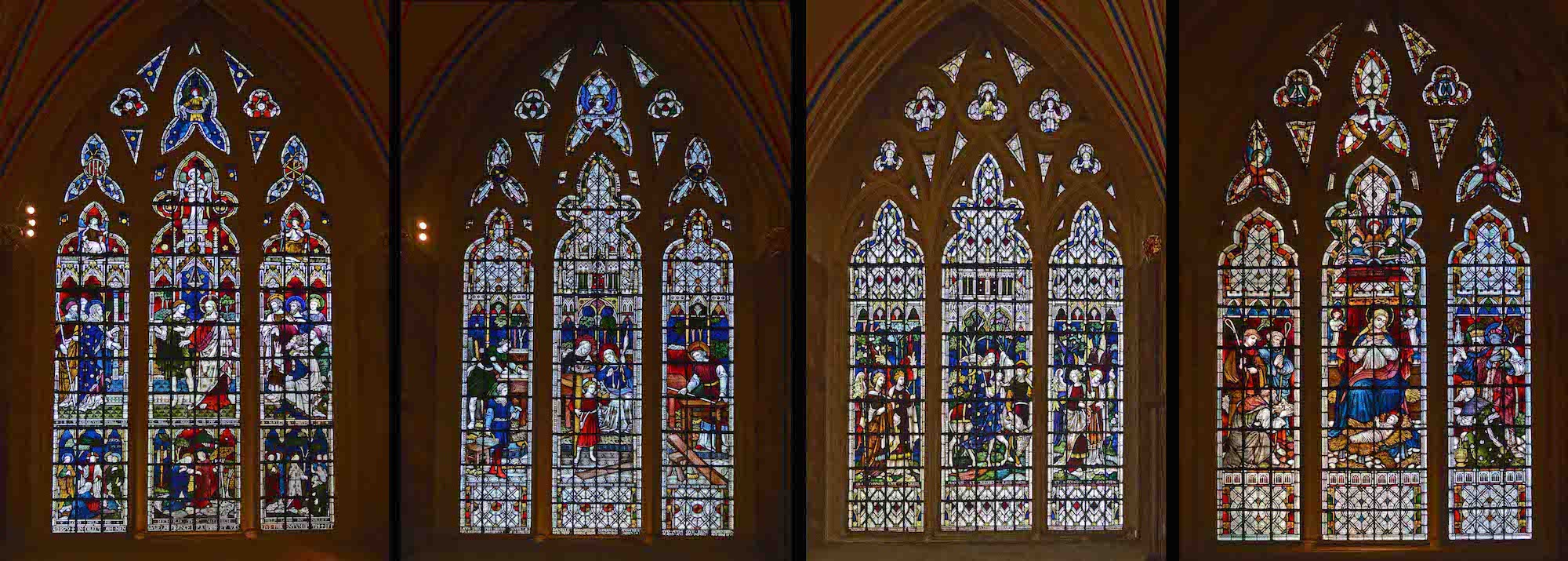41. NORTH WALL OF SOUTH TRANSEPT
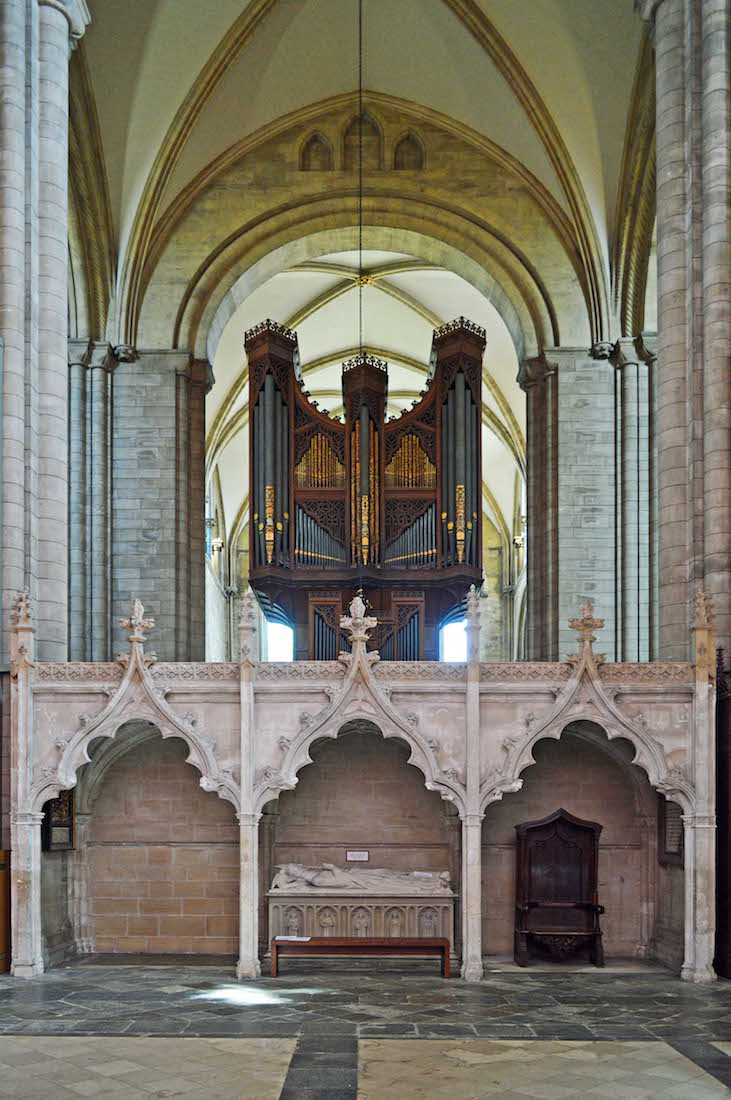
Looking to the North, the organ towers above the sleeping form of Bishop Robert Stratford. Robert de Stratford (c. 1292 – 1362) was an English bishop and was one of Edward III of England's principal ministers. From 1334 – 1337, Stratford was Archdeacon of Canterbury. He became Bishop of Chichester in 1337. PLAN
42. TOMB CHEST OF ROBERT STRATFORD
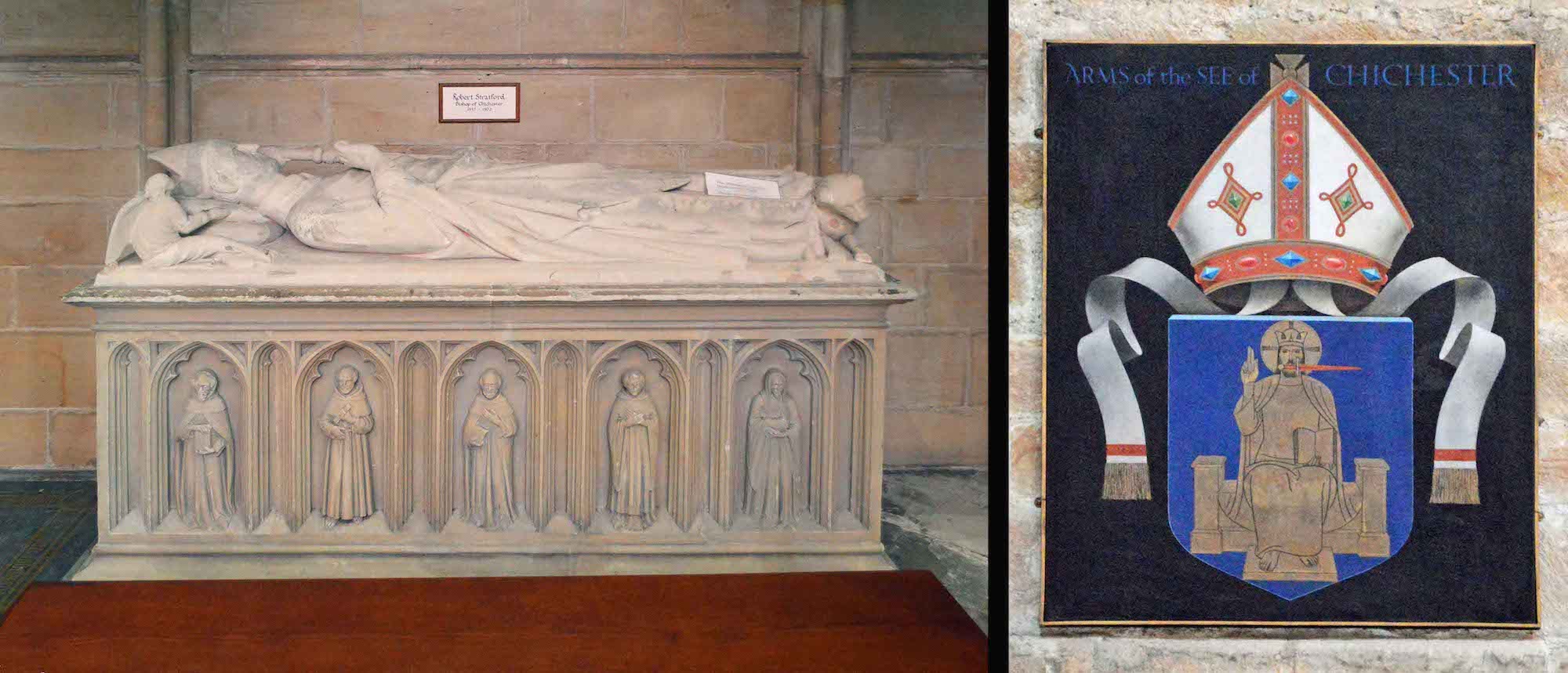
The tomb chest of Bishop Robert Stratford is much restored: the visible figures and niches were sculpted by E Richardson in 1846. The effigy is made of Beer stone. Nearby are displayed the arms of the See of Chichester. As mentioned earlier (#15), the Christ figure illustrates Revelation 19:15 : ‘From his mouth comes a sharp sword with which to strike down the nations, and he will rule them with a rod of iron.’
43. OLD CUPBOARD
We leave the South transept and move to the South quire aisle. We come immediately to an old 15th century oak cupboard, claimed to have slits (not visible?) for offerings. It is thought it might once have contained relics. The top is beautifully carved.
44. SOUTH QUIRE AISLE
The South quire aisle leading to the Chapel of Mary Magdalene is relatively uncluttered. We notice the red and gold bosses, the wall plaques at top right with monuments below, and the glass insert in the floor. A slightly fanciful St David looks down from the window.
45. ROBERT SHERBURNE, AND LAZARUS AND BETHANY
On the outer wall of the South quire aisle we find this memorial to Robert Sherburne who was Bishop of Chichester 1508 – 1536. Sherburne was Dean of St Paul’s (1499–1505), and from 1505 to 1508 he was bishop of St David’s. To the right are the Chichester Reliefs: two panel sculptures, side by side, illustrating the story of Lazarus. The sculptures are thought to be part of a chancel screen. They were discovered in 1829 hidden behind the choir stalls.
46. ON VIEW IN THE SOUTH QUIRE AISLE
Clockwise, from top left ... . A tomb chest monument to Walter Hook (1798 – 1875) who became Dean of Chichester. // Plaques to poet Henry King (1592 – 1669), Bishop of Chichester, and Eric Kemp, Bishop of Chichester 1974 – 2001. // The Ven Lancelot Mason (1965 – 1990) was an eminent Anglican priest who was appointed Archdeacon of Chichester in 1946. He additionally became a Canon Residentiary at the Cathedral in 1949; and retired from both posts in 1973. // The glass window in the floor of the aisle reveals the remains of an old Roman mosaic pavement.
47. SOUTH QUIRE AISLE WINDOWS
The left window depicts the coats of arms of various Sussex cities. The window was given by the people of Sussex to commemorate the coronation of Queen Elizabeth II. The right window shows the coats of arms of a number of early Bishops of Chichester.
48. MARY MAGDALENE CHAPEL, WADDINGTON MEMORIAL
We now approach the Chapel of Mary Magdalene at the East end of the South quire aisle. The chapel has a simple altar with a painting standing on it, and a couple of stained glass windows. Just to our right is a large monument – the Waddington memorial, dedicated to Frances Waddington. Her husband Edward Waddington (1670?–1731) was an English prelate who was bishop of Chichester from 1724 to 1731.
49. CHAPEL WINDOWS
The setting of the East window (left) is clearly the taking down of the body of Jesus after the Crucifixion. This is indicated by the lower scenes, and the items being carried by Joseph of Arimathea and Mary Magdalene. The central figure is Jesus, bound before the Crucifixion. The smaller Southern window shows the stoning of Stephen with the words in Latin : ‘May Jesus receive my spirit.’
50. CHAPEL PAINTING
The painting by Graham Sutherland is called ‘Noli me Tangere’ – Touch me not. It depicts a moment that has attracted a number of artists, when the Risen Christ speaks to Mary Magdalene outside the tomb. There are some teasingly uncertain elements within this picture. An exotic bird in an aperture which looks disturbingly like a heavenly eye. A keyhole at the foot of the stairs. Do the steps lead to a door? A small stool beside the woman at the foot of the stairs.
51. HIGH EAST WINDOWS
From the Chapel of Mary Magdalene we move across to an area of the Cathedral called the Retroquire – a space East of the high altar, from where the Lady Chapel extends. High above are these three windows. These appear to be of the type – anti-type style with Old Testament scenes below contrasting with upper New Testament scenes. Thus from left: the Annunciation and the burning bush; the Crucifixion and Adam and Eve in the garden; the baptism of Jesus and _?_ .
52. CHRIST IN JUDGEMENT
Above the doors leading to the Lady Chapel is a dark sculpted figure, the meaning of which becomes clear from this model or maquette. The figure is ‘Christ in Judgement’ sculpted by Philip Jackson. The figure of Christ sits on a throne, clad in his burial clothes. With his right hand he blesses, and in his left hand he holds a sword, in readiness to dispense justice.
53. ST RICHARD SHRINE
If we stand in the retroquire and look West, immediately before us is a very large and colourful tapestry. To the left is a statue of St Richard dating from 1938, and to the right the tomb of Bishop Barlow. The tapestry screen was designed by the German artist Ursula Benker-Schirmer in 1985. It illustrates some of the miracles of St Richard. A bone of St Richard’s from the reliquary of the Abbey de La Lucerne is interred under a simple slab beneath the altar; a sanctuary candle burns near it. William Barlow, who died in 1568, was an English Augustinian prior who became bishop of four dioceses!
54. ICON OF ST RICHARD
An icon of St Richard is attached to a column to the Northeast of the shrine. Richard of Chichester (1197 – 1253), is a saint (canonized in 1262) who was Bishop of Chichester. In his eight years as a bishop, Richard had become so beloved of the people of Sussex that the Cathedral became an important place of pilgrimage. In the Cathedral a shrine dedicated to Richard had become a richly decorated centre of pilgrimage. In 1538, during the reign of Henry VIII, the shrine was plundered and destroyed by order of Thomas Cromwell. Nowadays, the rebuilt shrine is a focus of prayer in the Cathedral.
55. ENTRY TO THE LADY CHAPEL, AND ORGAN
As we proceed into the Lady Chapel, we notice the Hurdis organ on our right. This Organ was built c.1780 at least partly by the Reverend James Hurdis, who was headmaster of the Prebendal School, and went on to be Professor of Poetry at Oxford University. In 1947, the Hurdis family gave the organ to the Prebendal School which in turn deposited it on loan to the Cathedral. It is currently housed here in the retrochoir, where it is regularly used to accompany services at the Shrine of St. Richard.
56. LADY CHAPEL
The original semicircular Lady Chapel was extended in the 12th centruy and again in the 13th century, and around this time the original small Norman windows were enlarged in Gothic style. The chapel was restored in 1871 –72 after the ravages of the Civil War, and has been used for the celebration of Holy Communion since 1891. During major refurbishment between 2007 and 2009, some of the original colour was reintroduced; hence the bright vermillion and blue now colouring the vault ribs at the eastern end, along with green, red and gold decorative work on the bosses and capitals.
57. LADY CHAPEL MEMORIALS
To the left as we enter, we notice several memorials. These are in memory of Lord Arthur Lennox, Bishop Thomas Bickley (1518 – 1596), Charles Henry Gordon Lennox, and Ralph de Luffa – Bishop of Chichester 1090 – 1123, and builder of this Church 1108 and 1114.
58. LADY CHAPEL NORTH WINDOWS
These stained glass windows, all by Clayton and Bell of London (1873-1888), portray scenes from the life of Jesus and show the important part that the Virgin Mary played in his life. The story can be followed by reading the windows in pairs North and South. In these Northerly windows we see from left: the Annunciation, the Visitation, and the arrival of Joseph and Mary in Bethlehem; the Presentation in the Temple; the twelve year old Jesus in the Temple discussing the scriptures with the doctors of the law; the Wedding at Cana, where Jesus turns water into wine.
59. LADY CHAPEL EAST WINDOW
This window by Clayton and Bell has five lights. The scene here is the Crucifixion. The text reads: ‘O Lamb of God that takest away the sins of the world, grant us peace.’
60. LADY CHAPEL SOUTH WINDOWS
In these Southerly windows we see at right the Nativity, and the Flight into Egypt. These are followed by a depiction of Jesus in Joseph’s carpentry workshop. The remaining window shows the occasion where Jesus tells his mother and brothers that those who do the will of God are also members of his family.


